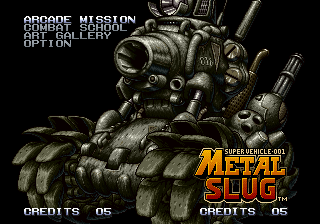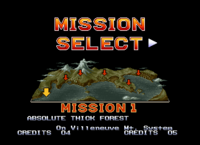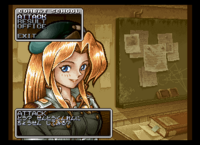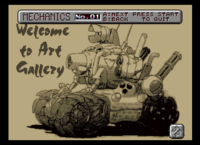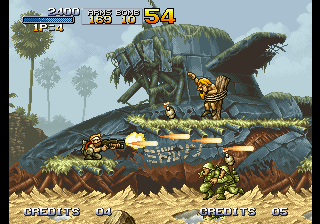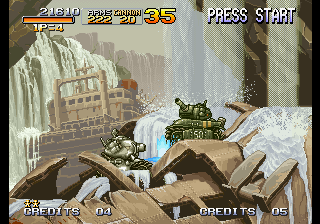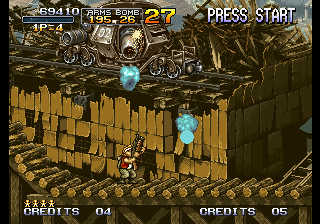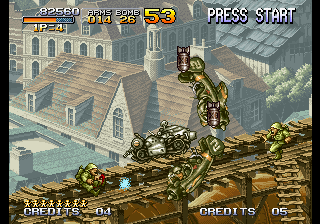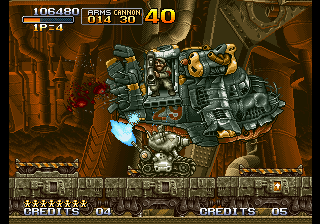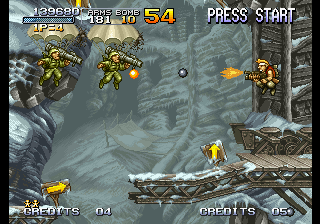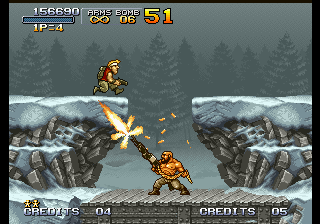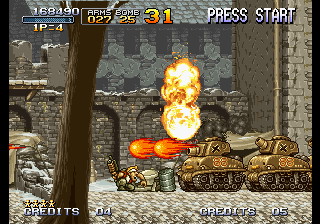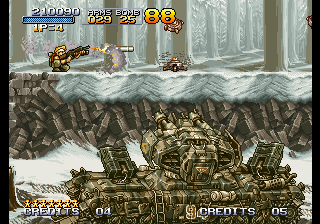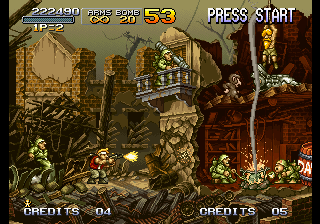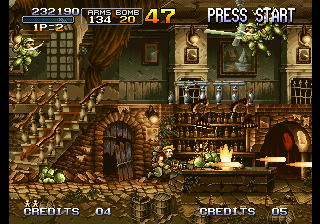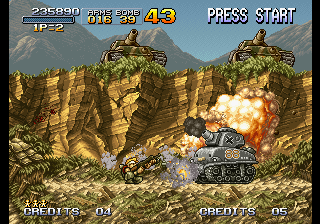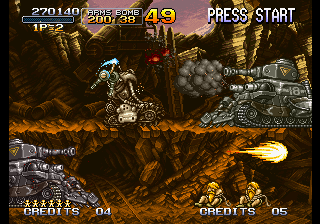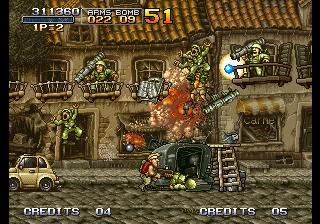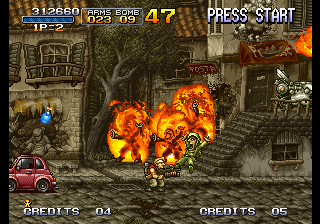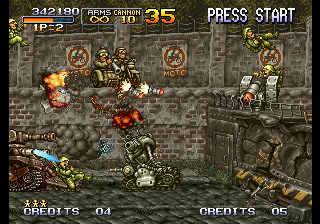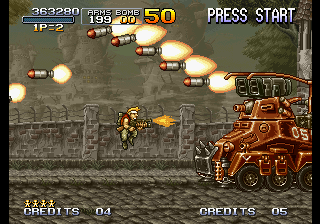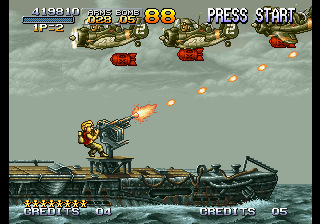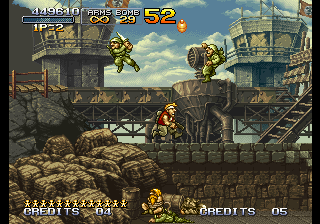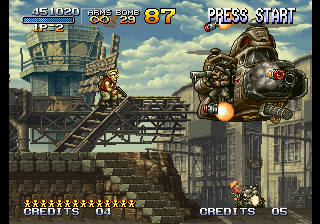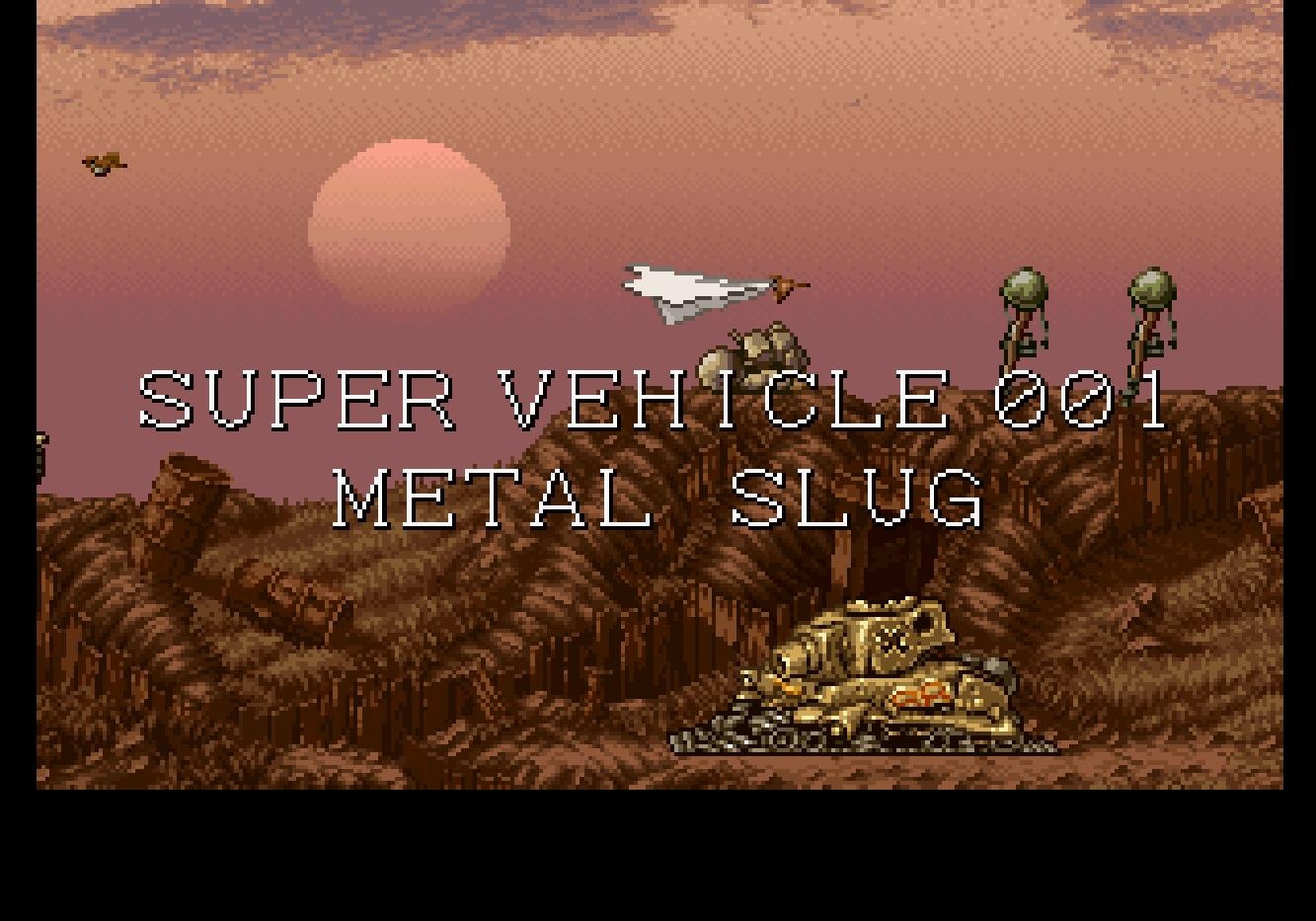Metal Slug
From Sega Retro
Metal Slug (メタルスラッグ) is a run-and-gun action platformer developed and published by SNK for their Neo Geo arcade hardware before being ported to numerous systems including the Sega Saturn. The game has been lauded for the quality of its artwork and sprite animation.
Contents
Story
The Peregrine Falcon Squad, a small but skilled team of soldiers serving under the Regular Army's special operations division, fights against the army of General Donald Morden in order to prevent a massive coup d'état and the creation of a New World Order.
Gameplay
Metal Slug is a run-and-gun game where players assume the role of Captain Marco Rossi (player one) and Lieutenant Tarma Roving (player two) of the Peregrine Falcon Strike Force, shooting at a continual stream of enemies in order to complete each stage. The game supports two-player simultaneous play. At the end of each stage, players confront a boss, who is usually considerably larger and tougher than regular enemies. Stages are timed and must be completed before time runs out. The player can move through the stage at any pace but cannot backtrack. The characters move with ![]() and
and ![]() , duck with
, duck with ![]() , and jump with
, and jump with ![]() . They fire their weapons with
. They fire their weapons with ![]() . The player can shoot the weapon directly upward with
. The player can shoot the weapon directly upward with ![]() +
+![]() while standing or jumping or directly downward with
while standing or jumping or directly downward with ![]() +
+![]() while jumping, but the weapon cannot be fired in diagonal directions. The default pistol has unlimited ammunition, but players can acquire more powerful weapons with limited ammunition. The characters use a knife instead when in melee range, which is more effective against enemies carrying shields. In addition, characters are armed with stick grenades, which are thrown in an arc with
while jumping, but the weapon cannot be fired in diagonal directions. The default pistol has unlimited ammunition, but players can acquire more powerful weapons with limited ammunition. The characters use a knife instead when in melee range, which is more effective against enemies carrying shields. In addition, characters are armed with stick grenades, which are thrown in an arc with ![]() for area damage. All weapons can be fired while ducking or jumping.
for area damage. All weapons can be fired while ducking or jumping.
Throughout each stage, players can find numerous weapon upgrades and the eponymous Metal Slug tanks. Known as the SV-001 and SV-002, the tanks increase the offense and defense of the characters. Like the unarmored characters, the tanks move with ![]() and
and ![]() , duck with
, duck with ![]() , and jump with
, and jump with ![]() . The tanks fire their guns with
. The tanks fire their guns with ![]() . The turret is rotated using the D-pad and remains in place until moved. The tanks have a secondary cannon, a powerful shell, that is fired with
. The turret is rotated using the D-pad and remains in place until moved. The tanks have a secondary cannon, a powerful shell, that is fired with ![]() . Like grenades, cannon shells are limited. The tanks can also throw grenades with
. Like grenades, cannon shells are limited. The tanks can also throw grenades with ![]() +
+![]() . Because the tanks do not change the direction that they face when they move backwards, cannons and grenades can only be fired forwards. The tanks can also kill infantry by running them over. The tanks can perform the Metal Slug Attack with
. Because the tanks do not change the direction that they face when they move backwards, cannons and grenades can only be fired forwards. The tanks can also kill infantry by running them over. The tanks can perform the Metal Slug Attack with ![]() +
+![]() , which is a self-destruct attack that drives the tank at enemies and provides the characters with temporary invulnerability after they leap out of the tank. The player can also exit the tank without destroying it with
, which is a self-destruct attack that drives the tank at enemies and provides the characters with temporary invulnerability after they leap out of the tank. The player can also exit the tank without destroying it with ![]() +
+![]() . It can be re-entered by jumping back into it.
. It can be re-entered by jumping back into it.
Much of the game's scenery is destructible, and occasionally, this reveals extra items or power-ups. During the course of a stage, the player encounters prisoners of war (POWs). The POWs can be freed by shooting at them (to break their bonds) and then moving near them, and they offer the player bonuses in the form of items or weapons. At the end of each stage, the player receives a scoring bonus based on the number of freed POWs. If the player dies before the end of the stage, the tally of freed POWs reverts to zero.
The characters lose a life after taking damage from an enemy weapon or a stage hazard but are not harmed by merely coming into contact with enemies. Characters also lose a life when they fall into bottomless pits or if the player runs out of time. When in a Slug, the characters gain a life bar that decreases when they take damage. The Metal Slug is destroyed when its life bar is depleted. The character can eject from it before it blows up with ![]() ; if the character remains in it when it is destroyed, the character loses a life. The game ends if the player runs out of lives but can be continued as long as the player has credits remaining.
; if the character remains in it when it is destroyed, the character loses a life. The game ends if the player runs out of lives but can be continued as long as the player has credits remaining.
The game has an expressive, fluid art style where characters react in exaggerated ways. Much of the game's humor comes from how the enemies are depicted; the player often encounters them as they are sunbathing, roasting food over a fire, or conversing. They tend to scream loudly if they see the player, and often try to either run away or fight back.
The player can replay stages in the standard Arcade Mission mode after completing them. There is a Combat School bonus mode that can be played after completing one stage. In this mode, players are given special challenges by Drill Instructor Sophia Greenville to complete. There is also an Art Gallery that includes concept art for the game.
Items
There are numerous other items (food, animals, medals, and coins) that provide bonus points.
| Item Crate | |
|---|---|
| Destroy to release an item. | |
| Bomb Crate | |
| Gives the player 10 grenades or 10 cannon shells if in a Slug. | |
| Ammo Crate | |
| Gives more ammunition for the current weapon or 1,000 points if no special weapon equipped. | |
| Metal Slug | |
| Jump in to control a Slug. | |
| Gas Can | |
| Restores some health to the Slug or gives 1,000 points if already at full health or not in a Slug. | |
| H Crate | |
| Equips the Heavy Machine Gun weapon. | |
| F Crate | |
| Equips the Flame Shot weapon. | |
| S Crate | |
| Equips the Shotgun weapon. | |
| R Crate | |
| Equips the Rocket Launcher weapon. |
Missions
| Absolute Thick Forest | |
|---|---|
| The boss is Tetsuyuki. | |
| A Wish for a Morning Glow | |
| The bosses are Mini-Bata and Hairbuster Riberts. | |
| Iron Cavalrymen in Hell | |
| The bosses are Allen O'Neil and Tani Oh. | |
| Death Valley | |
| The bosses are Shoe & Karn. | |
| The City Under Despotism | |
| The boss is Iron Nokana. | |
| The Memorial Sea | |
| The boss is Hi-Do. |
Production credits
- Design: Akio, Susumu, Max.D, Tomohiro, T.Okui, Kozo
- Planning: Meeher, Kire-Nag
- Sound: Hiya!, Jim
- Program: Hamachan, Andy, A.Kurooka, T.Yokota, H.Yamada, Pierre
- 本多 秀成, 山川 秀治, 渋谷 麻紀夫, 角田 貴市, 島倉 啓光, 木下 隆志, 井田 寧, 佐々木 研悟
Magazine articles
- Main article: Metal Slug/Magazine articles.
Promotional material
Physical scans
| Sega Retro Average | ||||||||||||||||||||||||||||||||||||||||||||||||||||||
|---|---|---|---|---|---|---|---|---|---|---|---|---|---|---|---|---|---|---|---|---|---|---|---|---|---|---|---|---|---|---|---|---|---|---|---|---|---|---|---|---|---|---|---|---|---|---|---|---|---|---|---|---|---|---|
|
| 75 | |
|---|---|
| Based on 10 reviews | |
Technical information
- Main article: Metal Slug/Technical information.
References
- ↑ http://gdri.smspower.org/wiki/index.php/Yumekobo
- ↑ File:MetalSlug Saturn JP Box Back.jpg
- ↑ 3.0 3.1 https://sega.jp/fb/segahard/ss/soft_licensee3.html (Wayback Machine: 2020-03-20 23:05)
- ↑ File:MetalSlug Saturn JP SSEnding.pdf
- ↑ Computer & Video Games, "August 1997" (UK; 1997-07-11), page 76
- ↑ Famitsu, "1997-04-11" (JP; 1997-03-28), page 1
- ↑ MAN!AC, "06/97" (DE; 1997-05-14), page 63
- ↑ Mega Fun, "07/97" (DE; 1997-06-04), page 71
- ↑ Next Generation, "August 1997" (US; 1997-07-22), page 119
- ↑ Saturn Power, "July 1997" (UK; 1997-05-28), page 78
- ↑ Sega Magazin, "Juli 1997" (DE; 1997-06-11), page 78
- ↑ Sega Saturn Magazine, "April 1998" (UK; 1998-03-11), page 68
- ↑ Sega Saturn Magazine, "1997-11 (1997-04-11)" (JP; 1997-03-28), page 178
- ↑ Sega Saturn Magazine, "Readers rating final data" (JP; 2000-03), page 11
| Metal Slug | |
|---|---|
|
Main page | Comparisons | Maps | Hidden content | Development | Magazine articles | Reception | Technical information | Bootlegs | |
